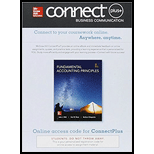
Requirement-1:
To calculate:
The amount of interest on bonds to be paid every six months
Requirement-1:
Answer to Problem 1E
Solution:
The amount of interest on bonds to be paid every six months is $153,000
Explanation of Solution
Explanation:
The amount of interest on bonds to be paid every six months is calculated as follows:
Bonds Par Value is $3,400,000
Annual interest rate on bonds is 9%
Semiannual interest rate on bonds shall be 9%/2 = 4.5%
Hence, the amount of interest on bonds to be paid every six months = 3,400,000*4.5% = $153,000
Conclusion:
The amount of interest on bonds to be paid every six months is $153,000
Requirement-2:
To prepare :
The journal entries for issuance and interest payment of bonds
Requirement-2:
Answer to Problem 1E
Solution:
The journal entries for issuance and interest payment of bonds are as follows:
| (a) | |||
| Date | Account titles | Debit | Credit |
| Jan. 1, 2015 | Cash | $ 3,400,000 | |
| Bonds payable | $3,400,000 | ||
| (b) Journal entry for the first interest payment | |||
| Date | Account titles | Debit | Credit |
| Jun. 30, 2015 | Interest Expense | $ 153,000 | |
| Cash | $ 153,000 | ||
| (b) Journal entry for the Second interest payment | |||
| Date | Account titles | Debit | Credit |
| Dec. 31, 2015 | Interest Expense | $ 153,000 | |
| Cash | $ 153,000 | ||
Explanation of Solution
Explanation:
The journal entries for issuance and interest payment of bonds are explained as follows:
| (a) Journal entry for issuance of bonds: | |||
| Date | Account titles | Debit | Credit |
| Jan. 1, 2015 | Cash | $ 3,400,000 | |
| Bonds payable | $3,400,000 | ||
| (Being bonds issued at par for cash) | |||
| (b) Journal entry for the first interest payment | |||
| Date | Account titles | Debit | Credit |
| Jun. 30, 2015 | Interest Expense (3400000*9%/2) | $ 153,000 | |
| Cash | $ 153,000 | ||
| (Being interest on bonds paid) | |||
| (b) Journal entry for the Second interest payment | |||
| Date | Account titles | Debit | Credit |
| Dec. 31, 2015 | Interest Expense (3400000*9%/2) | $ 153,000 | |
| Cash | $ 153,000 | ||
| (Being interest on bonds paid) | |||
Conclusion:
The amount of interest on bonds to be paid every six months is $153,000
Requirement-3:
To prepare :
The journal entries for issuance of bonds at a price 98 and 102
Requirement-3:
Answer to Problem 1E
Solution:
The journal entries for issuance of bonds are as follows:
| (a) Journal entry for issuance of bonds at 98: | |||
| Date | Account titles | Debit | Credit |
| Jan. 1, 2015 | Cash | $ 3,332,000 | |
| Discount on bonds payable | $ 68,000 | ||
| Bonds payable | $ 3,400,000 | ||
| (b) Journal entry for issuance of bonds at 102: | |||
| Date | Account titles | Debit | Credit |
| Jan. 1, 2015 | Cash | $ 3,468,000 | |
| Premium on bonds payable | $ 68,000 | ||
| Bonds payable | $ 3,400,000 | ||
Explanation of Solution
Explanation:
The journal entries for issuance of bonds are explained as follows:
| (a) Journal entry for issuance of bonds at 98: | |||
| Date | Account titles | Debit | Credit |
| Jan. 1, 2015 | Cash (3400000*98/100) | $ 3,332,000 | |
| Discount on bonds payable (3400000-3332000) | $ 68,000 | ||
| Bonds payable | $ 3,400,000 | ||
| (Being bonds issued at discount for cash) | |||
| (b) Journal entry for issuance of bonds at 102: | |||
| Date | Account titles | Debit | Credit |
| Jan. 1, 2015 | Cash (3400000*102/100) | $ 3,468,000 | |
| Premium on bonds payable (3468000-3400000) | $ 68,000 | ||
| Bonds payable | $ 3,400,000 | ||
| (Being bonds issued at premium for cash) | |||
Want to see more full solutions like this?
Chapter 14 Solutions
Connect 2-Semester Access Card for Fundamental Accounting Principles

 AccountingAccountingISBN:9781337272094Author:WARREN, Carl S., Reeve, James M., Duchac, Jonathan E.Publisher:Cengage Learning,
AccountingAccountingISBN:9781337272094Author:WARREN, Carl S., Reeve, James M., Duchac, Jonathan E.Publisher:Cengage Learning, Accounting Information SystemsAccountingISBN:9781337619202Author:Hall, James A.Publisher:Cengage Learning,
Accounting Information SystemsAccountingISBN:9781337619202Author:Hall, James A.Publisher:Cengage Learning, Horngren's Cost Accounting: A Managerial Emphasis...AccountingISBN:9780134475585Author:Srikant M. Datar, Madhav V. RajanPublisher:PEARSON
Horngren's Cost Accounting: A Managerial Emphasis...AccountingISBN:9780134475585Author:Srikant M. Datar, Madhav V. RajanPublisher:PEARSON Intermediate AccountingAccountingISBN:9781259722660Author:J. David Spiceland, Mark W. Nelson, Wayne M ThomasPublisher:McGraw-Hill Education
Intermediate AccountingAccountingISBN:9781259722660Author:J. David Spiceland, Mark W. Nelson, Wayne M ThomasPublisher:McGraw-Hill Education Financial and Managerial AccountingAccountingISBN:9781259726705Author:John J Wild, Ken W. Shaw, Barbara Chiappetta Fundamental Accounting PrinciplesPublisher:McGraw-Hill Education
Financial and Managerial AccountingAccountingISBN:9781259726705Author:John J Wild, Ken W. Shaw, Barbara Chiappetta Fundamental Accounting PrinciplesPublisher:McGraw-Hill Education





